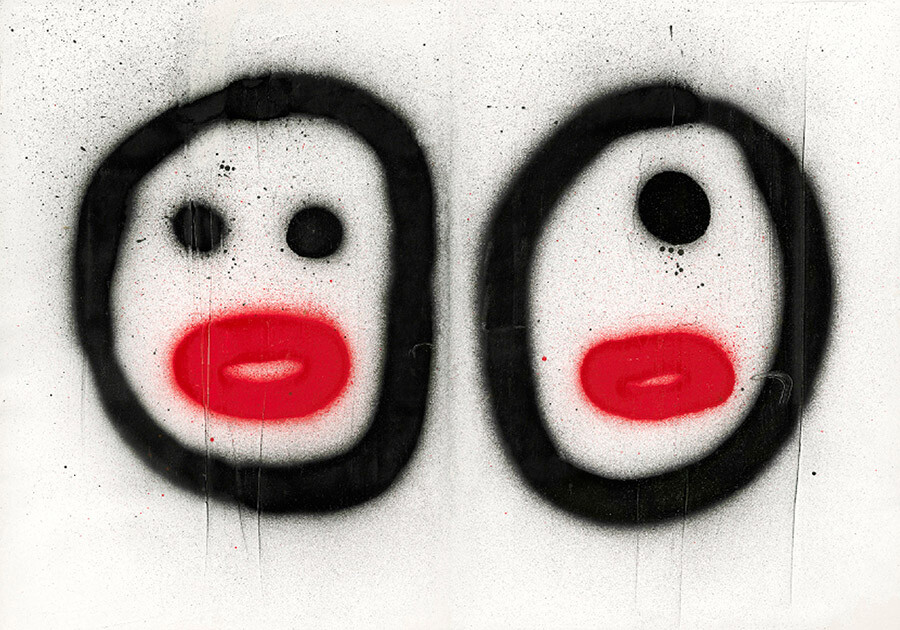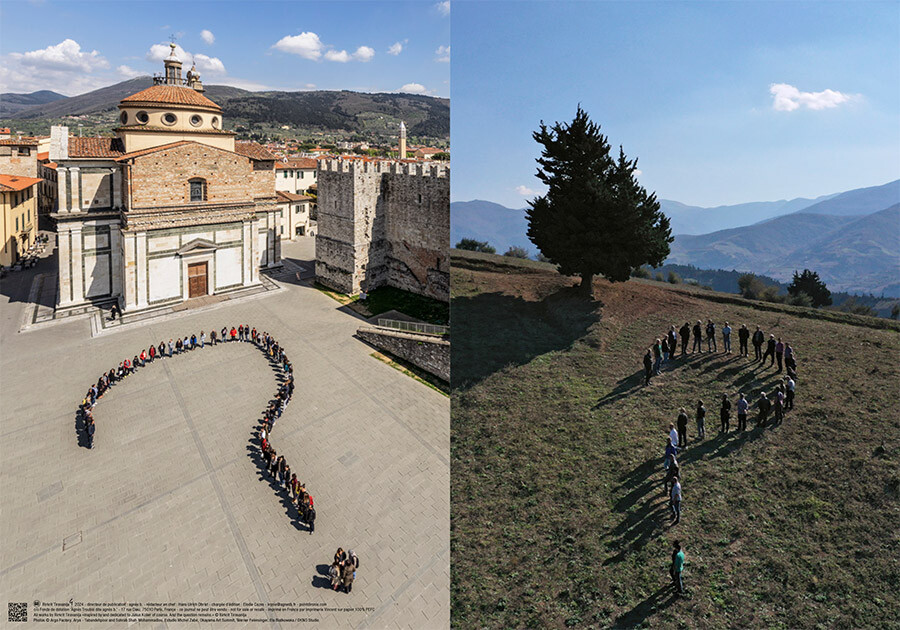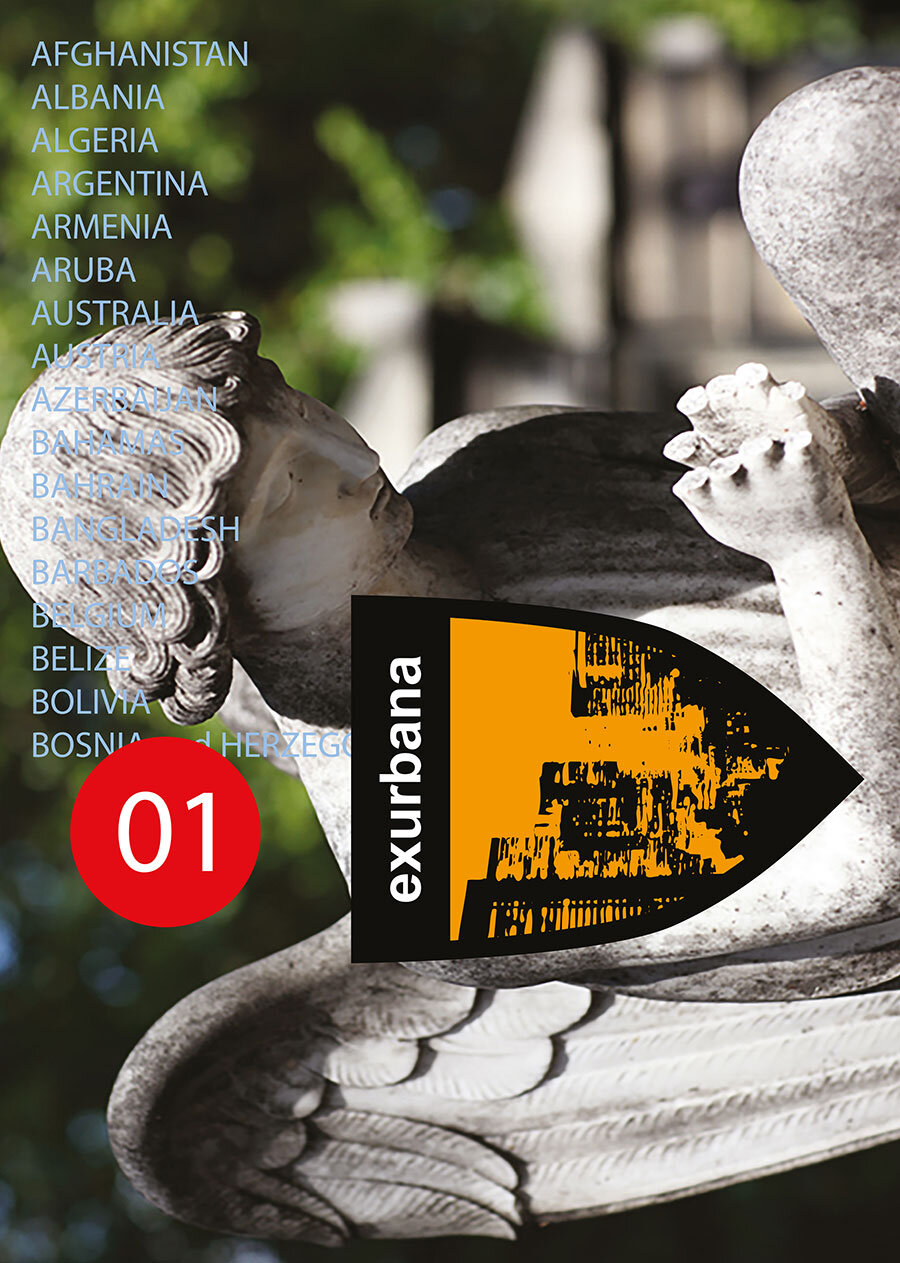Gérard Zlotykamien
n° 69
Gérard Zlotykamien, born in 1940 in Paris,
has developed an artistic practice deeply influenced by human tragedies and injustice. Since 1963, he has been engaging with public space through his « Éphémères, » ethereal figures symbolizing the fragility of existence and the memory of those who have disappeared.« I paint characters in their simplest expression. I remove all ornamentation. To explain this, I will refer to a quote from Nietzsche (it sounds fancy) that I read somewhere, which says: ‘There are people who stir the water to make it seem deeper.’ Well, I do exactly the opposite. I make it clearer. I strive to go to the minimum. My paintings are syntheses.
I am a painter of the ephemeral; I don’t believe things are permanent. Everything is ephemeral, even if it lasts for millions of years. The lifespan of my works in the street has never been important to me. What matters to me is the philosophical thought behind it and what remains of it. Because something always remains somewhere, for someone. A memory, a feeling, a trace. In reality, my spontaneity is deliberate. » Gérard Zlotykamien, Sur nos murs, 40 Years of Graffiti with agnès b., Textuel Editions
n° 69
Gérard Zlotykamien, born in 1940 in Paris,
has developed an artistic practice deeply influenced by human tragedies and injustice. Since 1963, he has been engaging with public space through his « Éphémères, » ethereal figures symbolizing the fragility of existence and the memory of those who have disappeared.« I paint characters in their simplest expression. I remove all ornamentation. To explain this, I will refer to a quote from Nietzsche (it sounds fancy) that I read somewhere, which says: ‘There are people who stir the water to make it seem deeper.’ Well, I do exactly the opposite. I make it clearer. I strive to go to the minimum. My paintings are syntheses.
I am a painter of the ephemeral; I don’t believe things are permanent. Everything is ephemeral, even if it lasts for millions of years. The lifespan of my works in the street has never been important to me. What matters to me is the philosophical thought behind it and what remains of it. Because something always remains somewhere, for someone. A memory, a feeling, a trace. In reality, my spontaneity is deliberate. » Gérard Zlotykamien, Sur nos murs, 40 Years of Graffiti with agnès b., Textuel Editions
Gérard Zlotykamien
n° 69
Gérard Zlotykamien, born in 1940 in Paris,
has developed an artistic practice deeply influenced by human tragedies and injustice. Since 1963, he has been engaging with public space through his « Éphémères, » ethereal figures symbolizing the fragility of existence and the memory of those who have disappeared.« I paint characters in their simplest expression. I remove all ornamentation. To explain this, I will refer to a quote from Nietzsche (it sounds fancy) that I read somewhere, which says: ‘There are people who stir the water to make it seem deeper.’ Well, I do exactly the opposite. I make it clearer. I strive to go to the minimum. My paintings are syntheses.
I am a painter of the ephemeral; I don’t believe things are permanent. Everything is ephemeral, even if it lasts for millions of years. The lifespan of my works in the street has never been important to me. What matters to me is the philosophical thought behind it and what remains of it. Because something always remains somewhere, for someone. A memory, a feeling, a trace. In reality, my spontaneity is deliberate. » Gérard Zlotykamien, Sur nos murs, 40 Years of Graffiti with agnès b., Textuel Editions
n° 69
Gérard Zlotykamien, born in 1940 in Paris,
has developed an artistic practice deeply influenced by human tragedies and injustice. Since 1963, he has been engaging with public space through his « Éphémères, » ethereal figures symbolizing the fragility of existence and the memory of those who have disappeared.« I paint characters in their simplest expression. I remove all ornamentation. To explain this, I will refer to a quote from Nietzsche (it sounds fancy) that I read somewhere, which says: ‘There are people who stir the water to make it seem deeper.’ Well, I do exactly the opposite. I make it clearer. I strive to go to the minimum. My paintings are syntheses.
I am a painter of the ephemeral; I don’t believe things are permanent. Everything is ephemeral, even if it lasts for millions of years. The lifespan of my works in the street has never been important to me. What matters to me is the philosophical thought behind it and what remains of it. Because something always remains somewhere, for someone. A memory, a feeling, a trace. In reality, my spontaneity is deliberate. » Gérard Zlotykamien, Sur nos murs, 40 Years of Graffiti with agnès b., Textuel Editions
Rirkrit Tiravanija
n° 68
Inspired by and dedicated to Július Koller of course. And the question remains.
Born 1961 in Buenos Aires, Argentina
Lives and works in New York, Berlin, and Chiang Mai
The work of Rirkrit Tiravanija has not stopped questioning the format of artworks and the exhibition system. A mix of performance, sculpture, installation, and more, with Tiravanija, the artistic space transforms into a place of social interaction, often dotted with meeting points, encounters, and exchanges. Frequently immaterial, his work invents new connections in a world based on reciprocity, conviviality, and hospitality. Whether transforming art centers and galleries into banquets, printing workshops, or pirate radio stations, the artist enjoys overcoming the usual spatial and temporal limitations of the 'white cube.'
With his ongoing project Rirkrit Tiravanija pays hommage to little-known Czechoslovakian conceptualist Július Koller, (1939-2007) who is both an inspiration and creative source for the artist. Based on Július Koller’s conceptual work, Rirkrit Tiravanija has developed since the early 2010 new works that reflect the subversion, irony and symbolic language of the Slovakian artist who dies in 2007.A question mark, a symbol which was frequently used by Koller, often as a subversive statement against the reality of life of the political system of the 70’s. Tiravanija restaged this question mark at Vienna’s St. Stephen’s Square with more than 100 participants or in Zocalo, Mexico City, as a recreation of Julius Koller’s 1970 performance, Universal Futurological Question Mark.
n° 68
Inspired by and dedicated to Július Koller of course. And the question remains.
Born 1961 in Buenos Aires, Argentina
Lives and works in New York, Berlin, and Chiang Mai
The work of Rirkrit Tiravanija has not stopped questioning the format of artworks and the exhibition system. A mix of performance, sculpture, installation, and more, with Tiravanija, the artistic space transforms into a place of social interaction, often dotted with meeting points, encounters, and exchanges. Frequently immaterial, his work invents new connections in a world based on reciprocity, conviviality, and hospitality. Whether transforming art centers and galleries into banquets, printing workshops, or pirate radio stations, the artist enjoys overcoming the usual spatial and temporal limitations of the 'white cube.'
With his ongoing project Rirkrit Tiravanija pays hommage to little-known Czechoslovakian conceptualist Július Koller, (1939-2007) who is both an inspiration and creative source for the artist. Based on Július Koller’s conceptual work, Rirkrit Tiravanija has developed since the early 2010 new works that reflect the subversion, irony and symbolic language of the Slovakian artist who dies in 2007.A question mark, a symbol which was frequently used by Koller, often as a subversive statement against the reality of life of the political system of the 70’s. Tiravanija restaged this question mark at Vienna’s St. Stephen’s Square with more than 100 participants or in Zocalo, Mexico City, as a recreation of Julius Koller’s 1970 performance, Universal Futurological Question Mark.
Rirkrit Tiravanija
n° 68
Inspired by and dedicated to Július Koller of course. And the question remains.
Born 1961 in Buenos Aires, Argentina
Lives and works in New York, Berlin, and Chiang Mai
The work of Rirkrit Tiravanija has not stopped questioning the format of artworks and the exhibition system. A mix of performance, sculpture, installation, and more, with Tiravanija, the artistic space transforms into a place of social interaction, often dotted with meeting points, encounters, and exchanges. Frequently immaterial, his work invents new connections in a world based on reciprocity, conviviality, and hospitality. Whether transforming art centers and galleries into banquets, printing workshops, or pirate radio stations, the artist enjoys overcoming the usual spatial and temporal limitations of the 'white cube.'
With his ongoing project Rirkrit Tiravanija pays hommage to little-known Czechoslovakian conceptualist Július Koller, (1939-2007) who is both an inspiration and creative source for the artist. Based on Július Koller’s conceptual work, Rirkrit Tiravanija has developed since the early 2010 new works that reflect the subversion, irony and symbolic language of the Slovakian artist who dies in 2007.A question mark, a symbol which was frequently used by Koller, often as a subversive statement against the reality of life of the political system of the 70’s. Tiravanija restaged this question mark at Vienna’s St. Stephen’s Square with more than 100 participants or in Zocalo, Mexico City, as a recreation of Julius Koller’s 1970 performance, Universal Futurological Question Mark.
n° 68
Inspired by and dedicated to Július Koller of course. And the question remains.
Born 1961 in Buenos Aires, Argentina
Lives and works in New York, Berlin, and Chiang Mai
The work of Rirkrit Tiravanija has not stopped questioning the format of artworks and the exhibition system. A mix of performance, sculpture, installation, and more, with Tiravanija, the artistic space transforms into a place of social interaction, often dotted with meeting points, encounters, and exchanges. Frequently immaterial, his work invents new connections in a world based on reciprocity, conviviality, and hospitality. Whether transforming art centers and galleries into banquets, printing workshops, or pirate radio stations, the artist enjoys overcoming the usual spatial and temporal limitations of the 'white cube.'
With his ongoing project Rirkrit Tiravanija pays hommage to little-known Czechoslovakian conceptualist Július Koller, (1939-2007) who is both an inspiration and creative source for the artist. Based on Július Koller’s conceptual work, Rirkrit Tiravanija has developed since the early 2010 new works that reflect the subversion, irony and symbolic language of the Slovakian artist who dies in 2007.A question mark, a symbol which was frequently used by Koller, often as a subversive statement against the reality of life of the political system of the 70’s. Tiravanija restaged this question mark at Vienna’s St. Stephen’s Square with more than 100 participants or in Zocalo, Mexico City, as a recreation of Julius Koller’s 1970 performance, Universal Futurological Question Mark.
Futura
n° 67
A pioneer when Graffiti met the formal gallery ecosystem, artist Futura (born Leonard Hilton McGurr) was known as early as the 1970s for his radical approach in the street, introducing abstraction to what was an entirely letter-based discipline. His work on canvas caught attention in the 1980s, and established him as a leading voice within a wider art movement that included the likes of Jean-Michel Basquiat, Keith Haring, and Kenny Scharf. Futura’s creativity— articulated across canvas, paper, sculpture, photography, graphic design, and large-scale mural work—shines as a result of its kinetic composition, elemental quality, and fully-original gestures.
“NO GUERRA is a creative representation of concepts, individuals, places, and ideas. thank you for your anti-war considerations...”
LEONARD HILTON McGURR aka FUTURA
n° 67
A pioneer when Graffiti met the formal gallery ecosystem, artist Futura (born Leonard Hilton McGurr) was known as early as the 1970s for his radical approach in the street, introducing abstraction to what was an entirely letter-based discipline. His work on canvas caught attention in the 1980s, and established him as a leading voice within a wider art movement that included the likes of Jean-Michel Basquiat, Keith Haring, and Kenny Scharf. Futura’s creativity— articulated across canvas, paper, sculpture, photography, graphic design, and large-scale mural work—shines as a result of its kinetic composition, elemental quality, and fully-original gestures.
“NO GUERRA is a creative representation of concepts, individuals, places, and ideas. thank you for your anti-war considerations...”
LEONARD HILTON McGURR aka FUTURA
Futura
n° 67
A pioneer when Graffiti met the formal gallery ecosystem, artist Futura (born Leonard Hilton McGurr) was known as early as the 1970s for his radical approach in the street, introducing abstraction to what was an entirely letter-based discipline. His work on canvas caught attention in the 1980s, and established him as a leading voice within a wider art movement that included the likes of Jean-Michel Basquiat, Keith Haring, and Kenny Scharf. Futura’s creativity— articulated across canvas, paper, sculpture, photography, graphic design, and large-scale mural work—shines as a result of its kinetic composition, elemental quality, and fully-original gestures.
“NO GUERRA is a creative representation of concepts, individuals, places, and ideas. thank you for your anti-war considerations...”
LEONARD HILTON McGURR aka FUTURA
n° 67
A pioneer when Graffiti met the formal gallery ecosystem, artist Futura (born Leonard Hilton McGurr) was known as early as the 1970s for his radical approach in the street, introducing abstraction to what was an entirely letter-based discipline. His work on canvas caught attention in the 1980s, and established him as a leading voice within a wider art movement that included the likes of Jean-Michel Basquiat, Keith Haring, and Kenny Scharf. Futura’s creativity— articulated across canvas, paper, sculpture, photography, graphic design, and large-scale mural work—shines as a result of its kinetic composition, elemental quality, and fully-original gestures.
“NO GUERRA is a creative representation of concepts, individuals, places, and ideas. thank you for your anti-war considerations...”
LEONARD HILTON McGURR aka FUTURA





